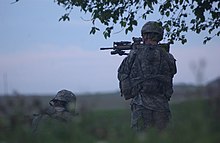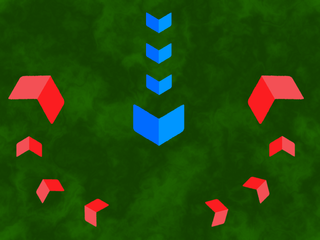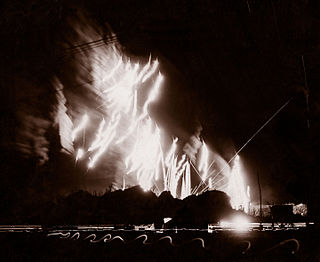This article includes a list of general references, but it lacks sufficient corresponding inline citations .(June 2023) |


Counter-sniper tactics have evolved in sniper warfare to reduce the effectiveness of snipers.
This article includes a list of general references, but it lacks sufficient corresponding inline citations .(June 2023) |


Counter-sniper tactics have evolved in sniper warfare to reduce the effectiveness of snipers.
During the stalking phase of their attack, a sniper will, if time allows, try to identify high-value targets, such as other snipers [1] or Senior officers and NCOs. They will do this by closely observing the behavior of the people in front of them. The intention is to identify who is in charge and then prepare to fire at them. It naturally follows that leaders should attempt to blend into the background by avoiding anything that distinguishes them from the most junior soldiers and attracts the interest of a sniper.
In order to reduce a sniper's ability to damage the chain of command, doctrine and equipment need to prevent any observable "leadership" behaviors and signs. Insignia, e.g. rank insignia, should be subdued (i.e. dark or black as opposed to bright colors), camouflage colors on battledress, battledress identical for all ranks, military servants and rank-based luxuries (like saluting) avoided in forward areas, and commands and instruction should be given discreetly. Additionally, other acts such as looking at maps, using a radio, pointing authoritatively, abstaining from menial tasks and other forms of body language can betray an officer's rank.
Because snipers use camouflage, choose their firing positions carefully, and often attack from long distances, they are difficult to locate. Gunfire locators have been developed to do this. These may sense a variety of signatures including:
When the trajectory of the bullet can be sensed, backtracking can be done to calculate the sniper's location. Sensor techniques are often used in combination to improve detection and eliminate false alarms. [2]
A friendly sniper is generally the most effective counter-sniper tool. With similar training, knowledge of the surroundings, and equipment, the friendly sniper can offer advice to the squad, enhanced searching capability, and combat the enemy sniper directly. When told what to watch for, the squad can also act as additional eyes and ears for the friendly sniper. Aside from watching over the squad, the friendly sniper also has the option to detach and engage the enemy sniper. Without any outside help from the squad, the respective skills of each sniper play a significant role in determining victory. The enemy sniper's skill can also be determined by the precision of their shots.
Once a sniper's position is known or suspected, other options follow:

A sniper is a military or paramilitary marksman who engages targets from positions of concealment or at distances exceeding the target's detection capabilities. Snipers generally have specialized training and are equipped with telescopic sights. Modern snipers use high-precision rifles and high-magnification optics. They often also serve as scouts/observers feeding tactical information back to their units or command headquarters.

The pincer movement, or double envelopment, is a military maneuver in which forces simultaneously attack both flanks (sides) of an enemy formation. This classic maneuver has been important throughout the history of warfare.

A metal detector is an instrument that detects the nearby presence of metal. Metal detectors are useful for finding metal objects on the surface, underground, and under water. A metal detector consists of a control box, an adjustable shaft, and a variable-shaped pickup coil. When the coil nears metal, the control box signals its presence with a tone, light, or needle movement. Signal intensity typically increases with proximity. A common type are stationary "walk through" metal detectors used at access points in prisons, courthouses, airports and psychiatric hospitals to detect concealed metal weapons on a person's body.

A smoke detector is a device that senses smoke, typically as an indicator of fire. Smoke detectors/Alarms are usually housed in plastic enclosures, typically shaped like a disk about 150 millimetres (6 in) in diameter and 25 millimetres (1 in) thick, but shape and size vary. Smoke can be detected either optically (photoelectric) or by physical process (ionization). Detectors may use one or both sensing methods. Sensitive alarms can be used to detect and deter smoking in banned areas. Smoke detectors in large commercial and industrial buildings are usually connected to a central fire alarm system.

Tracer ammunition, or tracers, are bullets or cannon-caliber projectiles that are built with a small pyrotechnic charge in their base. When fired, the pyrotechnic composition is ignited by the burning powder and burns very brightly, making the projectile trajectory visible to the naked eye during daylight, and very bright during nighttime firing. This allows the shooter to visually trace the trajectory of the projectile and thus make necessary ballistic corrections, without having to confirm projectile impacts and without even using the sights of the weapon. Tracer fire can also be used as a marking tool to signal other shooters to concentrate their fire on a particular target during battle.
Measurement and signature intelligence (MASINT) is a technical branch of intelligence gathering, which serves to detect, track, identify or describe the distinctive characteristics (signatures) of fixed or dynamic target sources. This often includes radar intelligence, acoustic intelligence, nuclear intelligence, and chemical and biological intelligence. MASINT is defined as scientific and technical intelligence derived from the analysis of data obtained from sensing instruments for the purpose of identifying any distinctive features associated with the source, emitter or sender, to facilitate the latter's measurement and identification.

In military science, suppressive fire is "fire that degrades the performance of an enemy force below the level needed to fulfill its mission". When used to protect exposed friendly troops advancing on the battlefield, it is commonly called covering fire. Suppression is usually only effective for the duration of the fire. It is one of three types of fire support, which is defined by NATO as "the application of fire, coordinated with the maneuver of forces, to destroy, neutralise or suppress the enemy".

A security alarm is a system designed to detect intrusions, such as unauthorized entry, into a building or other areas, such as a home or school. Security alarms protect against burglary (theft) or property damage, as well as against intruders. Examples include personal systems, neighborhood security alerts, car alarms, and prison alarms.

Infantry tactics are the combination of military concepts and methods used by infantry to achieve tactical objectives during combat. The role of the infantry on the battlefield is, typically, to close with and engage the enemy, and hold territorial objectives; infantry tactics are the means by which this is achieved. Infantry commonly makes up the largest proportion of an army's fighting strength, and consequently often suffers the heaviest casualties. Throughout history, infantrymen have sought to minimise their losses in both attack and defence through effective tactics.

A motion detector is an electrical device that utilizes a sensor to detect nearby motion. Such a device is often integrated as a component of a system that automatically performs a task or alerts a user of motion in an area. They form a vital component of security, automated lighting control, home control, energy efficiency, and other useful systems. It can be achieved by either mechanical or electronic methods. When it is done by natural organisms, it is called motion perception.

A sentry gun is a weapon that is automatically aimed and fired at targets that are detected by sensors. The earliest functioning military sentry guns were the close-in weapon systems point-defense weapons, such as the Phalanx CIWS, used for detecting and destroying short range incoming missiles and enemy aircraft, first used exclusively on naval assets, and now also as land-based defenses.

A gunfire locator or gunshot detection system is a system that detects and conveys the location of gunfire or other weapon fire using acoustic, vibration, optical, or potentially other types of sensors, as well as a combination of such sensors. These systems are used by law enforcement, security, military, government offices, schools and businesses to identify the source and, in some cases, the direction of gunfire and/or the type of weapon fired. Most systems possess three main components:
In land warfare, artillery sound ranging is a method of determining the coordinates of a hostile battery using data derived from the sound of its guns firing, so called target acquisition.

Bounding overwatch is a military tactic of alternating movement of coordinated units to allow, if necessary, suppressive fire in support of offensive forward "fire and movement" or defensive "center peel" disengagement.

Special reconnaissance (SR) is conducted by small units, such as a recon team, made up of highly trained military personnel, usually from special forces units and/or military intelligence organizations. Special reconnaissance teams operate behind enemy lines, avoiding direct combat and detection by the enemy. As a role, SR is distinct from commando operations, but both are often carried out by the same units. The SR role frequently includes covert direction of airstrikes and indirect fire, in areas deep behind enemy lines, placement of remotely monitored sensors, and preparations for other special forces. Like other special forces, SR units may also carry out direct action and unconventional warfare, including guerrilla operations.

Boomerang is a gunfire locator developed by DARPA and BBN Technologies primarily for use against snipers. Boomerang is mounted on mobile vehicles such as the Humvee, Stryker, and MRAP combat vehicles. There were plans to integrate it into the Land Warrior system.

People sniffer was the field name for a series of U.S. Army issued "personnel detectors" used during the Vietnam War. The purpose was to detect enemy soldiers in hidden positions, which were often employed in the jungle combat conditions of Vietnam. The U.S. military used two different versions of the people sniffer, one backpack version and one helicopter-mounted version.
The Battle of Prek Klok I occurred on February 28, 1967 during Operation Junction City, a search and destroy mission by American military forces in Tay Ninh Province of South Vietnam, to the west of the capital Saigon. A few days before the battle, the 1st Battalion, 16th Infantry Regiment was brought into the area near Suoi Da and Prek Klok to defend a highway, airfield, and artillery base in the area, and to carry out search and destroy operations around it. On the morning of 28 February, elements of the battalion headed east, and were attacked from the front by Viet Cong (VC) infantry with gunfire, rockets and mortars. Soon after, they were attacked from all fronts as the VC tried to surround them with a battalion-sized force. However, with superior firepower available, the Americans called in air strikes and artillery, and by mid afternoon, had repelled the VC attacks. The Americans lost 25 killed while the VC lost 167.

The United States armed forces classify reconnaissance missions as "close" or "short-range"; "distant" or "medium-range"; and "deep" or "long-range".
{{citation}}: CS1 maint: numeric names: authors list (link)